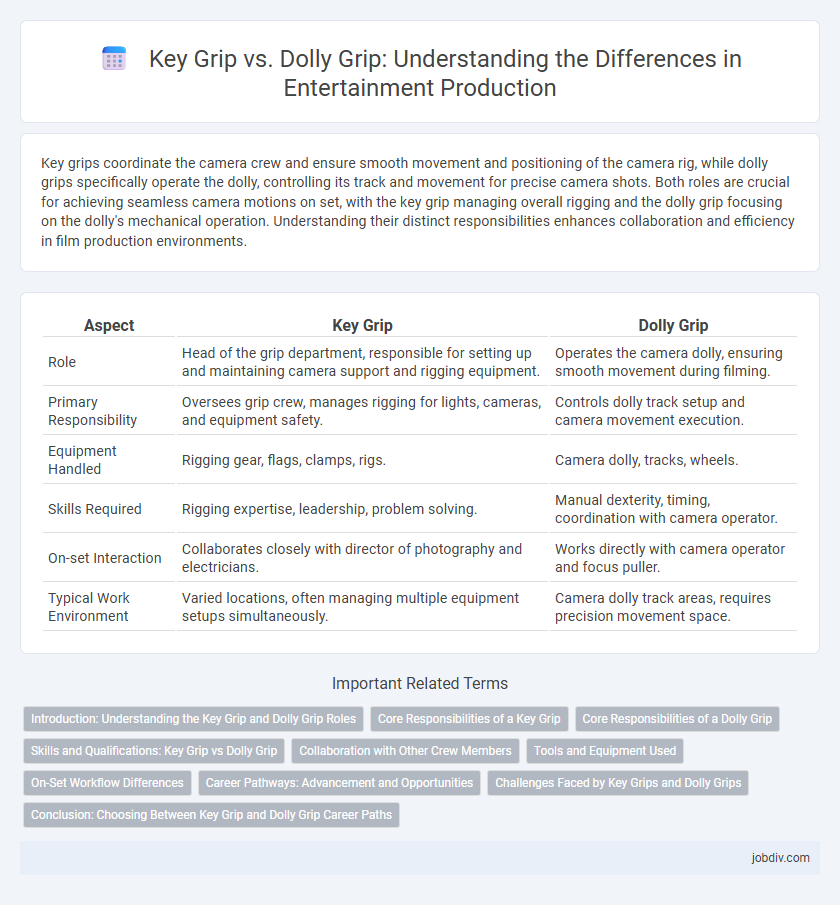Key grips coordinate the camera crew and ensure smooth movement and positioning of the camera rig, while dolly grips specifically operate the dolly, controlling its track and movement for precise camera shots. Both roles are crucial for achieving seamless camera motions on set, with the key grip managing overall rigging and the dolly grip focusing on the dolly's mechanical operation. Understanding their distinct responsibilities enhances collaboration and efficiency in film production environments.
Table of Comparison
| Aspect | Key Grip | Dolly Grip |
|---|---|---|
| Role | Head of the grip department, responsible for setting up and maintaining camera support and rigging equipment. | Operates the camera dolly, ensuring smooth movement during filming. |
| Primary Responsibility | Oversees grip crew, manages rigging for lights, cameras, and equipment safety. | Controls dolly track setup and camera movement execution. |
| Equipment Handled | Rigging gear, flags, clamps, rigs. | Camera dolly, tracks, wheels. |
| Skills Required | Rigging expertise, leadership, problem solving. | Manual dexterity, timing, coordination with camera operator. |
| On-set Interaction | Collaborates closely with director of photography and electricians. | Works directly with camera operator and focus puller. |
| Typical Work Environment | Varied locations, often managing multiple equipment setups simultaneously. | Camera dolly track areas, requires precision movement space. |
Introduction: Understanding the Key Grip and Dolly Grip Roles
The Key Grip oversees the camera rigging and movement equipment, ensuring smooth and safe camera operation on set. The Dolly Grip specializes in operating the camera dolly, precisely executing camera movements as directed by the cinematographer. Both roles collaborate closely to enhance the visual storytelling through technical expertise and coordination.
Core Responsibilities of a Key Grip
The Key Grip oversees all grip equipment and coordinates the crew responsible for camera rigging, lighting support, and safety on set. They collaborate closely with the Director of Photography to shape lighting and camera movement, ensuring smooth and precise setups. Core responsibilities include managing rigging, assembling dollies, cranes, and tracks, and maintaining a safe working environment during film production.
Core Responsibilities of a Dolly Grip
A Dolly Grip specializes in operating and maneuvering the camera dolly, ensuring smooth, precise camera movements during filming to enhance shot composition and visual storytelling. This role requires coordinating with the camera operator and director of photography to execute complex tracking shots, maintaining stability and fluid motion. Unlike the Key Grip, who manages overall rigging and lighting support, the Dolly Grip's core responsibility centers on camera movement logistics and safety on set.
Skills and Qualifications: Key Grip vs Dolly Grip
Key grips require expertise in rigging, lighting modifications, and safety protocols to support camera movement and set stability, showcasing strong technical and leadership skills. Dolly grips specialize in operating camera dollies with precision and smoothness, necessitating excellent coordination and an in-depth understanding of camera equipment and tracking paths. Both roles demand physical strength, teamwork abilities, and familiarity with film set dynamics to ensure seamless visual storytelling.
Collaboration with Other Crew Members
Key Grips and Dolly Grips collaborate closely with camera operators, directors of photography, and lighting technicians to ensure smooth camera movement and precise shot framing on set. The Key Grip coordinates rigging and safety measures, while the Dolly Grip operates the camera dolly, synchronizing their efforts for seamless visual storytelling. This teamwork enhances production efficiency and supports the creative vision during complex scenes.
Tools and Equipment Used
Key grips primarily utilize tools such as C-stands, flags, clamps, and rigging equipment to shape and control lighting on set, ensuring the desired visual effect. Dolly grips operate specialized dollies equipped with tracks, wheels, and mounts designed to smoothly move cameras during shots, requiring precise handling of the dolly system and camera rig. Both roles demand expertise with their specific tools to support cinematographers in achieving dynamic and visually compelling scenes.
On-Set Workflow Differences
Key grips coordinate camera rigging, lighting setups, and safety on set, focusing on overall equipment placement and movement. Dolly grips specifically operate the camera dolly, ensuring smooth, precise camera movements and tracks during scenes. The key grip orchestrates team workflow and equipment logistics, while the dolly grip executes the dynamic positioning of the camera, highlighting distinct responsibilities in on-set collaboration.
Career Pathways: Advancement and Opportunities
Key grips oversee camera rigging and lighting adjustments, commanding leadership roles on set with opportunities to advance to the rigging department head or camera equipment coordinator. Dolly grips specialize in operating camera dollies, offering career growth toward senior dolly grip positions and potential transition into camera operation or assistant camera roles. Mastery in either discipline opens pathways to union membership, increased project responsibility, and higher-profile film or television productions.
Challenges Faced by Key Grips and Dolly Grips
Key grips and dolly grips encounter distinct challenges on set, with key grips managing heavy rigging and ensuring the safety of complex camera setups under tight schedules. Dolly grips face the difficulty of synchronizing precise camera movements with actors' blocking while navigating uneven terrain or confined spaces. Both roles demand quick problem-solving skills and adaptability to maintain smooth production flow and capture dynamic shots efficiently.
Conclusion: Choosing Between Key Grip and Dolly Grip Career Paths
Choosing between a Key Grip and a Dolly Grip career depends on one's affinity for either general camera rigging and lighting control or specialized camera movement operation. Key Grips oversee the rigging of lighting and camera support equipment, requiring strong leadership and technical skills, while Dolly Grips focus on executing smooth and precise camera movements, demanding dexterity and timing. Both roles are vital in film production, offering unique challenges and opportunities for those passionate about the physical aspects of cinematography and on-set collaboration.
Key Grip vs Dolly Grip Infographic

 jobdiv.com
jobdiv.com